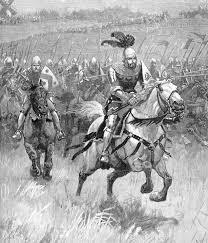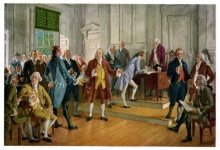Difference between revisions of "American Independence and English Common Law"
| (33 intermediate revisions by 2 users not shown) | |||
| Line 1: | Line 1: | ||
{{Article | {{Article | ||
| − | | | + | |HasCategory=English Common Law and Constitution |
| − | | | + | |HasSummary='''American Independence and English Common Law''' " 'Government is a conditional compact between king and people. A violation of the covenant by either party discharges the other from its obligation.' 'An Act [of Parliament] against the Constitution is void.' In these thirty words Patrick Henry and James Otis denied the divine origin of the British kingship and the legislative supremacy of the British Parliament, and substituted therefor the Common Law and the eternal rights of man." |
| − | + | |HasAuthor=WikiSysop | |
| + | |HasArticleDate=2014/01/16 | ||
| + | }} | ||
| + | {{SectionDefault | ||
| + | |HasArticleText=''This article was the first written on CW. It was written as a trial horse for purposes of developing the site rather than as a real treatise on the subject of its title.'' | ||
| + | |||
| − | + | "‘Government is a conditional compact between king and people. ... A violation of the covenant by either party discharges the other from its obligation.’ ‘An Act [of Parliament] against the Constitution is void.’ In these thirty words Patrick Henry and James Otis denied the divine origin of the British kingship and the legislative supremacy of the British Parliament, and substituted therefor the Common Law and the eternal rights of man." Thus starts Volume III of Edward Channing’s ‘A History of the United States’. Spain, England, and France had established colonies on the Caribbean Islands and North and Central America for reasons of empire and commerce. The colonists themselves had their own compelling reasons to face the hardship and long odds that were the daily life of creating civilization in a wilderness. The motives and interests of the colonists and the governments and corporations that sent them were ever at odds, but as civilization and commerce emerged and matured in the New World, those conflicting interests could no longer be ignored. | |
| − | + | The words of Americans Henry and Otis in 1760 foreshadowed the colonists reasons for secession from England. Their desire to enjoy the same rights as those subjects living in England and the same liberties that were protected by English Common Law was at the core. We can, therefore, legitimately trace the American movement for independence to the origins of England’s Common Law. It transformed England from feudal anarchy to a constitutional society and set the expectations of those who settled America. This Common Law represented to the English and their spin-offs, a guarantee of inalienable rights. It was the legal recognition of such rights and it placed the rule of law above the rule of men. | |
| − | + | The foundation of Common Law was laid by the Plantagenet King Henry II in opposition to localized courts run by the Lord of the Manor and the Church. Without the Norman invasion of William the Conqueror (Henry II’s great grandfather), in which he defeated England’s King Harold II at the Battle of Hastings (1066), England would likely have remained in a Continental state of Baronial feudalism for perhaps centuries more (as did much of the Continent),and the colonies in America would have been denied their rallying principle for independence. | |
| − | Trevelyan, | + | It is a long thread from the Battle of Hastings in 1066 to the United States Declaration of Independence in 1776. |
| + | |||
| + | |||
| + | '''References:''' | ||
| + | |||
| + | * Channing, Edward "A History of the United States." The Macmillan Company, 1920 | ||
| + | * Trevelyan, G.M "History of England." Longmans, Green and Company Ltd., Third Edition 1945, Book II, Chapter 1. | ||
|HasImage=Timeline.jpg | |HasImage=Timeline.jpg | ||
| − | |HasImageTitle= | + | |HasImageTitle=From the Battle of Hastings to American Independence |
| − | |HasImageDescription=*1066 Battle of Hastings | + | |HasImageDescription=*1066 Battle of Hastings established the Plantagenet kings |
| − | *1154-1189 Reign of Henry II | + | *1154-1189 Reign of Henry II, the founder of Common Law |
| − | *1215 Magna Carta | + | *1215 Magna Carta - Limitations placed on the king's authority |
*1587 1st English colony in Virginia | *1587 1st English colony in Virginia | ||
*1620 Grant of New England; the Pilgrims arrive in the Mayflower | *1620 Grant of New England; the Pilgrims arrive in the Mayflower | ||
| − | *1760-1763 The beginning of an era | + | *1760-1763 The beginning of an era of American independence |
*1776 United States Declaration of Independence | *1776 United States Declaration of Independence | ||
| − | | | + | |HasImage2=Declaration.jpg |
| − | | | + | |HasImageTitle2=United States Declaration of Independence |
| + | |HasImageDescription2=*1776 United States Declaration of Independence | ||
}} | }} | ||
| + | {{Citations}} | ||
Latest revision as of 22:42, 6 February 2015
American Independence and English Common Law " 'Government is a conditional compact between king and people. A violation of the covenant by either party discharges the other from its obligation.' 'An Act [of Parliament] against the Constitution is void.' In these thirty words Patrick Henry and James Otis denied the divine origin of the British kingship and the legislative supremacy of the British Parliament, and substituted therefor the Common Law and the eternal rights of man." 2014/01/16 User:WikiSysop
| From the Battle of Hastings to American Independence | |

|
| United States Declaration of Independence | |

|
This article was the first written on CW. It was written as a trial horse for purposes of developing the site rather than as a real treatise on the subject of its title.
"‘Government is a conditional compact between king and people. ... A violation of the covenant by either party discharges the other from its obligation.’ ‘An Act [of Parliament] against the Constitution is void.’ In these thirty words Patrick Henry and James Otis denied the divine origin of the British kingship and the legislative supremacy of the British Parliament, and substituted therefor the Common Law and the eternal rights of man." Thus starts Volume III of Edward Channing’s ‘A History of the United States’. Spain, England, and France had established colonies on the Caribbean Islands and North and Central America for reasons of empire and commerce. The colonists themselves had their own compelling reasons to face the hardship and long odds that were the daily life of creating civilization in a wilderness. The motives and interests of the colonists and the governments and corporations that sent them were ever at odds, but as civilization and commerce emerged and matured in the New World, those conflicting interests could no longer be ignored.
The words of Americans Henry and Otis in 1760 foreshadowed the colonists reasons for secession from England. Their desire to enjoy the same rights as those subjects living in England and the same liberties that were protected by English Common Law was at the core. We can, therefore, legitimately trace the American movement for independence to the origins of England’s Common Law. It transformed England from feudal anarchy to a constitutional society and set the expectations of those who settled America. This Common Law represented to the English and their spin-offs, a guarantee of inalienable rights. It was the legal recognition of such rights and it placed the rule of law above the rule of men.
The foundation of Common Law was laid by the Plantagenet King Henry II in opposition to localized courts run by the Lord of the Manor and the Church. Without the Norman invasion of William the Conqueror (Henry II’s great grandfather), in which he defeated England’s King Harold II at the Battle of Hastings (1066), England would likely have remained in a Continental state of Baronial feudalism for perhaps centuries more (as did much of the Continent),and the colonies in America would have been denied their rallying principle for independence.
It is a long thread from the Battle of Hastings in 1066 to the United States Declaration of Independence in 1776.
References:
- Channing, Edward "A History of the United States." The Macmillan Company, 1920
- Trevelyan, G.M "History of England." Longmans, Green and Company Ltd., Third Edition 1945, Book II, Chapter 1.
- 1066 Battle of Hastings established the Plantagenet kings
- 1154-1189 Reign of Henry II, the founder of Common Law
- 1215 Magna Carta - Limitations placed on the king's authority
- 1587 1st English colony in Virginia
- 1620 Grant of New England; the Pilgrims arrive in the Mayflower
- 1760-1763 The beginning of an era of American independence
- 1776 United States Declaration of Independence
- 1776 United States Declaration of Independence
Timeline.jpg Declaration.jpg From the Battle of Hastings to American Independence United States Declaration of Independence